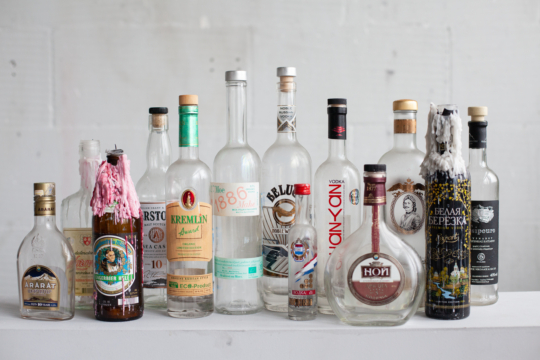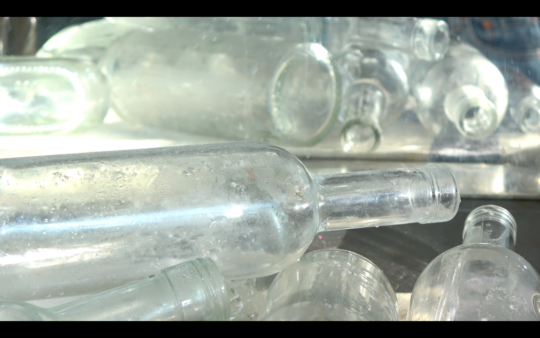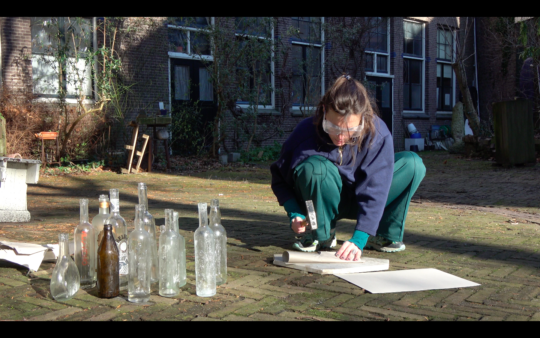
Once glorious gifts from your travels,
vessels of a sweetness
so icy it turned oily,
burning our throats
and untying
our tongues:
clumsily aligned on my mantelpiece,
thirteen empty bottles
get grimy.
Post-heart-break, what to do with gifts
when they turn to ache?
1.
“Hero, in [Virginia] Woolf’s dictionary, is bottle. The hero as bottle, a stringent reevaluation. I now propose the bottle as hero.
Not just the bottle of gin or wine, but bottle in its older sense of container in general, a thing that holds something else.”1
–
On our first date, you brought
a translucent Dalmatian rakija,
38% of alcohol
yellow-labelled Lozovača;
the bottle was half empty
/
half full.
–
La part des anges, the angels’ share.
About 4% of distilled liquors vanish
as volatile vapours
through the oak barrels’ pores.
Sand, soda ash and limestone
melt in the furnace at 1200°C to a texture that resembles syrup
on a winter day.
With a metal rod, her blowing ‘punti’, she collects a gub of the glowing paste.
She blows, she turns, she twists, she holds and gently supports as she heats, paddles, flips and lets gravity do its work.
Each bottle encapsulates a glassblower’s breath.
You poured yourself a glass
and sat across the table.
You looked down
and bit your lips,
and finally
splashed your words
over me.
–
Held tight by his thumb and palm, the bottle rests on his four fingers. He directs her at an upward angle, aiming at nothing. He loosens the metal cage that muzzles her cork, and fiddles to find a seam that runs along the length of her sides; her most vulnerable point. With a sharp blade, he strikes her neck in a friction that he knows will weaken her integrity;
one stroke,
two strokes,
three strokes.
Sabered,
her decapitated mouth flies into emptiness.
[cheer]
–
I let out a foamy froth of rage.
–
Past my tantrum,
the bitter regret.
What I shattered cannot be whole again.
–
As a child,
I once broke a crystal glass,
and scooped the shards under the carpet.
I grew up learning
it was safer to lie,
carefully hide
all evidence,
and accept hell would eventually break loose.
2.
Recipe for ‘cobwebbing’*:
Gather your bottles, treat them well.
Wipe away the dust, and scrape off their label.
Crush them to pieces. Allow yourself to crash.
Mould a crucible. Bring the glass oven to 850°C.
Let the broken shards slowly melt together in the furnace.
Dissolve distress into confusion.
Transform hollowness into steadiness.
Immersed under hot water in my sink, I scrub my thirteen bottles clean and peel off their signs. Turned anonymous, I dry the transparent shapes. I wrap each bottle in a sheet of paper, twisting the surplus on both ends, like giant candy offerings. In the crisp winter sunlight, I hold the first bottle tight to the cold ground of my courtyard. With a hammer I start hitting in a slow cadence; my beating is still timid, unsure of itself. The paper shreds from each impact; my safety screen is peeling off.
I wrap again.
I hit again.
Until.
In one motion.
I hear the bottle collapse
inwards.
“Glass is silent until it breaks.”2
I feel the brokenness contained into the folded paper.
I hit again.
I need to obtain a homogeneous matter, a gritty gravel. But the bottle’s thick bottom does not surrender. Shards lacerate the wrapping sheet.
It gets messy.
Incisive particles escape my protective blanket.
It gets risky.
Cracking along a disordered molecular net that characterise liquids,
a glass’ broken edge turns into the sharpest of blades.
I unfold my bounty and contemplate the light piercing through a small mount of broken fragments.
Coated in white powdery substance, they resemble chunks of crystalized salt.
Compacted tears.
I repeat thirteen times.
3.
I arrive at the workshop holding thirteen envelopes filled with crushed glass.
Warmed by the radiant heat of the furnace,
I hope to find solace.
Sol-
the sun is both alone and whole.
I sculpt a simple shape out of clay; a pebble, a seed, a cell, a bean, a beginning. I enclose the mother mould in wooden walls, pour plaster and silica thickened to the consistency of a flowy yoghurt or heavy cream. I leave them to cure.
I carve the clay away, leaving a negative shape hollowed from the solid white mould. I fill up the void with my shards of glass, my precious ‘cullet’ crushed to grit and dust. I carefully avoid leaving gaps between layers; there can be no air bubbles. I return to the oven.
The kiln is a low geometrical trunk. A treasure chest. Its top surface is a door that opens up to a concave space defined by insulation bricks stacked with a heat-resistant mortar. The inner surface is traversed by metallic spirals coiled into grooves. I load my mould and close the door.
Spirals convey a controlled heat, delivered at a slow and constant pace, not exceeding a speed of 100ºC per hour. After several hours, the temperature rises to glass melting point.
Inside the mould, shards get dull. Their edges blend. Lulled. Soothe. The sharpness of my thoughts softens. Particles melt into each other. A magma, a viscous moosh.
Glowing.
Annealing process
follows,
to cool off the mass at a gradual rate
and slowly release internal stress.
Warning: when melting together glass originating from different manufacturers, various coefficients of thermal expansion might not be compatible. During the cooling down phase of a solid work, the fused particles might separate, crumble and eventually lead the piece to explode. With kiln casting, consider with care chemical compatibility matters.
4.
After six cooling days,
I can release my piece.
A heavy block, a stone, a newborn.
3,6 kg of solid cast glass.
Crack crack,
leftover mould flakes off the surface of my gem.
Pop pop pop,
it may take months for her inner tension to settle down.
For safety, I wrap her in a blanket.
The omphalos stone was presented to Kronos wrapped in a swaddling cloth.
Before swallowing what he believed was his fate-bearer son,
the titan asks his wife to nurse the stone.
Deceitfully
spilling her milk over
the mineral navel,
the titaness sparked a swirling galaxy.
I was never great at giving gifts.
I bring over my glass block to your place.
She resembles a loaf of bread. I wish for companionship.
Hidden in the folds of her protective blanket,
I finally return the key to your house.
* “This act of self-love refers to purging any mementos from previous relationships (old sweaters, text threads or photos) in an effort to move on.”
[1] “The Carrier Bag Theory of Fiction” by Ursula K. Leguin, 1986 – Dancing at the Edge of the World (1989, Grove press, New York).[2] Title of a performance by Mathild Clerc-Verhoeven (2023, Oosterkerk in Amsterdam) where the artist investigates the place of glass in public space and emulates the process of de-polishing glass.
Marie Ilse Bourlanges (1983, Paris) is an artist based in Amsterdam, whose practice combines tangible, performative and written matter, with collaborative and individual trajectories. Through an eco-feminist lens, her work aims at reconsidering and shifting power dynamics, between humans and across species.

